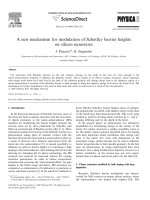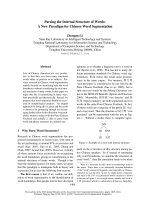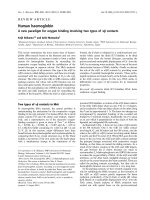A new algorithm for enumeration of minimum cutsets of graph by branch addition
Bạn đang xem bản rút gọn của tài liệu. Xem và tải ngay bản đầy đủ của tài liệu tại đây (412.36 KB, 6 trang )
1
Abstract: Nowadays, reliability is one of the most important
studies of power systems. There are different methods to
enumerate power system's reliability indices such as series-
parallel simplification, minimum path and minimum cutset.
When the network has a simple reliability block diagram and
this block consists of only series and/or parallel elements, it can
be easily found the link between input nodes and output nodes
and reliability indices calculation is very easy. However, in
complex reliability block diagram, series-parallel simplification
cannot be used and other algorithms should be searched in such
cases. Some of these algorithms, which are based on finding
minimum paths, need a large size of memory and more
computation time. Thus, these algorithms are also not useful in
complex systems. In this paper, a new minimum cutset
enumeration algorithm is presented, that can be a suitable
method in such systems.
Several methods have been proposed to minimum cutests
enumeration in journals and literatures. In this paper, a suitable
algorithm that is not sensitive to number of input nodes of graph
will be introduced. Calculation of all order of minimum cutsets
of a given graph in a simple way is another advantage of the
proposed method. The novel algorithm takes less time to
calculate minimum cutsets, compared with others. As a case
study, this algorithm is applied to the IEEE 7 bus test network
and also to a part of Iran transmission and subtransmission
system (Khorasan regional network).
Index Terms: Minimum Cutset, Minimum Cutset
Enumeration, Reliability and Reliability Block Diagram.
I. I
NTRODUCTION
INIMUM CUTSET is an effective method to calculate
reliability indices of complex networks. However, there
are some techniques, which do not use cutset; the enumeration
of all minimum cutset is a fundamental step in many
algorithms for evaluating the network reliability. Besides,
minimum cutset is a useful routine for failure modes studying
of the system and their effects analysis.
Many calculation methods have been proposed to
minimum cutset evaluation. Primary algorithms are based on
finding minimum paths. Depth First Search (DFS) technique
has been used in these methods. This technique is difficult for
This work was supported by the Department of Power System Study,
Nirro Research Institute, Tehran, Iran.
N.Moslemi and J.Abbasi are with the Department of Power System Study,
Niroo Research Institute, Tehran 1468617151, Iran (email:
, )
A.Rabiee is with the Department of Electrical Engineering, IUST
University, Tehran, Iran (email: )
programming and it needs a large size of memory and more
computation time. A basic algorithm uses vertex set and
minimum cutset generation trees [1]. Monte-Carlo simulation
has been used in another algorithm, which involves minimum
path calculation [2]. Computing minimum cutset of a cyclic
directed graph is also proposed in [3]. Series-parallel and
delta-star reduction is technique has been used in [4].
Recursive algorithm to enumerate minimum cutset of a
directed graph, using dynamic programming technique has
been used in [5]. An efficient algorithm is also presented for
undirected graphs in [6]. None of the foregoing algorithms has
a scheme to compute the minimum cutset of graph with more
than one input node. Most of them calculate minimum cutset
in special conditions, but in real power networks with many
input and output nodes, a fast algorithm with minimum
searching is needed, due to the great number of minimum
cutsets.
Some notations and definitions are given in section 2. In
section 3 and 4, the minimum cutset algorithm is explained in
more details and developed. The new algorithm is presented in
section 5. Case study is illustrated in section 6 and section 7
includes conclusion.
II. N
OTATIONS
&
D
EFINITIONS
1, 2, 3…: nodes (branches) numbers in graph.
G = (N, B): graph with node set N and branch set B
Minimum Cutset: for a given graph G = (N, B) with a set
of input and output nodes, a subset of branches (C
⊂
B) is a
Minimum Cutset, if and only if deleting all branches in C
divides G into some separate graphs. Therefore, one of these
graphs includes some output nodes and others include at least
one input node.
A: node-node connection matrix of graph
row i: all branches in i
th
row of connection matrix (A).
III. R
EVIEW OF
C
UTSET
E
NUMERATION
A
LGORITHM BY
B
RANCH
A
DDITION
[6]
Consider the following graph. Node set {1, 2, 3} is a
connected subgraph. Branch set {e4, e5} disjoints this node
set from node set {4}.
A New Algorithm for Enumeration of Minimum
Cutsets of Graph by Branch Addition
J. Abbasi, N. Moslemi and A. Rabiee
M
1
2
3
4
e1
e5
e4
e2
e3
Figure 1: A graph with four nodes
2005 IEEE/PES Transmission and Distribution
Conference & Exhibition: Asia and Pacific
Dalian, China
0-7803-9114-4/05/$20.00 ©2005 IEEE.
1
2
Figure 3: Graph Fig. 2 after deleting of the cutest branches
Figure 2: Graph with an input and output node
For the above graph, the node-node connection matrix is as
following:
In order to calculate the cutset that disjoints node set {1, 3}
from main graph, the following stages should be done step by
step:
1- row 1 and row 3 are added (C = row1+ row 3)
row 1= {e
1
, e
2
}
row 3 = { e
2
, e
3
, e
5
}
row 1+ row 3={ e
1
, e
2
, e
2
, e
3
, e
5
}
2- after deleting repetitive branches from C, the remained
branches will be a cutest.
e
2
is a repetitive branch, therefore it is deleted:
cutset: {e
1
, e
3
, e
5
}
The algorithm with the connection matrix as its input
parameter includes following steps:
1. An arbitrary node (for example node a) is selected as start
node.
2. A not search node adjacent to node a (for example node k),
is selected.
3. For each node of graph (r
i
= 1, 2… n and
kn ≠
) do the
following stages:
3-1. row r
i
is a cutest
3-2. Find node set s, adjacent nodes to node r
i
and s
j
>r
i
and
s
j
≠ k, the {row r
i
+row s
j
– {repetitive branches in row r
i
+ row s
j
}} is a cutest.
3-3. Find node set t, adjacent nodes to node s
j
and t
l
>s
j
and
t
l
≠ k, the {row r
i
+ row s
j
+ row t
l
– {repetitive branches
in row r
i
+row s
j
+row t
l
}} is a cutest.
3-4. Next nodes sets with 4, 5…, n-1 nodes are calculated
easily by searching adjacent nodes of previous nodes set
and cutsets are computed in accordance with the
previously routine, has done in 3-2 and 3-3.
This algorithm is applied to the graph shown in Figure1. Node
1 is the start node (a=1) and node 2 is chosen as the adjacent
node that not search (k=2). The calculated cutsets are:
1) row 1= { e
1
, e
2
}
2) row1+ row3 - {e
2
} = {e
1
, e
3
, e
5
}
3) row 1+ row 3 + row 4 – { e
2
, e
5
}= { e
1
, e
3
, e
4
}
4) row 3= { e
2
, e
3
, e
5
}
5) row 3+ row4 – { e
5
}={ e
2
, e
3
, e
4
}
6) row 4 = { e
4
, e
5
}
IV. D
EVELOPMENT OF THE BRANCH ADDITION ALGORITHM FOR
GRAPH WITH SOME INPUT NODES
As the algorithm suffices to division of graph by cutset
regardless of the input and output nodes, it is possible to have
both input and ouput nodes in a subgraph simultaneously.
This causes the conflict in the definition of minimum cutset.
However, this problem can be solved easily. For this
approach, above algorithm should be changed as follows:
1. Algorithm should start with an output node.
2. The node set made for minimum cutset enumeration,
should not include input node.
3. Every minimum cutset must be divided graph to some
subgraphs and each subgraph must be containing at least
an input node.
According to the definition of minimum cutset, for a
connected subgraph with output node(s), deleting all
connected branches to that subgraph must be divide the main
graph, except the subgraph that contains the output node, into
some connected subgraphs, that each of them must be contains
at least one input node. The graph, shown in Figure 2
contradicts the above statement.
In the graph of Figure 2, node 1 is an output node and node
5 is an input node. Node set {1, 2, 3} is a connected subgraph
with an output node.
According to this algorithm branch set {3, 4, 5, 8} is a cutset
of node set {1, 2, 3}. After deleting branches of the cutset, the
main graph, except the subgraph that contains the output
node, will be divided into three connected subgraph. Node set
{6, 7}, introduces a connected subgraph that dos not contains
any input node. So the branch set {3, 4, 5, 8} can not be a
minimum cutset. In order to solve this problem, each of
subgraphs, which are resulted from the deleting branches of
the cutsets from the main graph, remain graph must be
checked, that has at least one input node.
Now it is time to present the new algorithm. Because of
using node-branch connection matrix takes fewer memories
and furthermore it involves all the information extracted from
node-node connection matrix, we will use it instead of node-
node connection matrix that the previous algorithm uses.
V. N
EW ALGORITHM TO CALCULATE MINIMUM CUTSETS
Inputs: n: number of graph nodes
m: number of input nodes
p: number of output nodes
C: the node-branch connection matrix, input nodes
and output nodes information
Output: All minimum cutsets of graph.
2
3
The algorithm will be repeated p times to evaluate
minimum cutsets of p output nodes. In each time, only one of
the output nodes will be considered. Then the minimum cutset
enumeration approach is performed. Calculating other output
node starts only after all the minimum cutsets of the previous
output node has been calculated.
To calculate the minimum cutsets for one output node, the
new algorithm at first deletes all connected branches to that
output node. All connected subgraphs, except one that
contains this output node, must be have at least one input
node. So deleted branches are a minimum cutset for this
output node. Then it finds all of node sets with two nodes (the
output node and one of its adjacent nodes that it is not an
input node) and for each of them deletes all branches that
connect it to main graph. These branches will be a minimum
cutset if and only if each of contained subgraphs has at least
one input node. This routine is performed for node sets with 3,
4… (n-m-1) nodes and the minimum cutsets are evaluated,
respectively. The flowchart of the new algorithm is shown in
figure 5.
VI. C
ASE STUDY
As a case study, this algorithm is applied to the IEEE 7 bus
test network, with three input nodes (G1,G2,G3) and two
output nodes (3,5), is shown in figure 9 and its minimum
cutsets for output node 3 are shown in Table 2. The
calculations have made by Matlab version 6.5. The cutsets of
this graph have calculated in 0.8 second.
This algorithm also has applied to a part of Iran
transmission and subtransmission system (Khorasan regional
network). This network that includes 97 nodes, 114 branches,
2 input nodes (1022, 150) and 1output node (19036), is shown
in figures 6, 7 and 8. The minimum cutsets for output node
19036 are shown in Table 1. For this case study, 252
minimum cutsets of order 2 (without any order 1) calculated
in 16 seconds. Since there are many minimum cutsets, high
order minimum cutsets are not shown in table.
VII. C
ONCLUSION
A simple and effective algorithm has proposed to
enumerate minimum cutsets of a graph with some input and
output nodes. The presented algorithm is insensitive to
number of input nodes. The ability to calculate any order of
minimum cutset is the other advantage of this method. The
most important advantage of the new algorithm is less time
consuming compared with the other minimum cutset
enumeration algorithms. Therefore, it is very suitable to use in
transmission system reliability studies and is efficient enough
to be applied to complex networks.
The output nodes determine that how many times the
algorithm should be performed and in each repetition of the
algorithm, only one of them is considered as output node of
the graph.
Load Network's Information
m= number of input node
p = number of output node
n = number of graph's nodes
u =0, k=0
u = u+1
The Uth output node is considered as output node
of graph to calculate cutset.
k =k+1
G
ki
= as connected subgraph with k nodes and
contains output node
.
L = Number of Gki , i=1
(Gk1 Gk2, Gk3,… , GkL)
Delete all branches connected to G
ki
i =i+1
Is each subgraph
contains at least one
in
put node?
i
≤
L
k
≤
n-m-1
u<p
END
START
Branches connected to G
ki
make a minimum cutset
Figure 5: Flowchart of the new algorithm
Yes
Yes
Yes
No
3
4
Row
Branch
No.
Node1
Node2
Row
Branch
No.
Node1
Node2
1 71 150 1462 63 1313 1804 1804
2 74 150 148 64 1312 1804 1804
3 75 150 156 65 1311 1804 1804
4 76 150 151 66 1310 1804 1804
5 77 150 152 67 1309 1804 1804
6 78 150 152 68 1308 1804 1803
7 79 152 153 69 1307 1032 1804
8 80 153 154 70 1306 1804 1804
9 81 153 155 71 1305 1804 1803
10 82 157 158 72 1304 1803 1803
11 83 157 160 73 1303 1803 1803
12 84 158 160 74 1302 1803 1803
13 85 158 159 75 1301 1803 1803
14 73 148 149 76 1300 1803 1803
15 72 148 147 77 1299 1803 1803
16 70 147 1461 78 1298 1803 1803
17 1385 157 156 79 1297 1803 1803
18 1350 1462 19032 80 1296 1803 1803
19 1351 19032 19033 81 1295 1802 1803
20 1352 19033 19034 82 1294 1802 1802
21 1353 19034 19035 83 1293 1802 1802
22 1354 19035 19036 84 1292 1802 1802
23 1355 19036 19037 85 1291 1802 1802
24 1356 19037 19038 86 1290 1802 1802
25 1357 19038 19019 87 1289 1802 1801
26 1349 1461 19031 88 1277 1801 1801
27 1348 19031 19039 89 1276 1801 1801
28 1347 19030 19029 90 1275 1801 1801
29 1346 19029 19028 91 1274 1801 1801
30 1345 19028 19027 92 1273 1801 1800
31 1344 19027 19026 93 1272 1800 1800
32 1343 19026 19025 94 1316 1800 1422
33 1342 19025 19024 95 1278 1801 1801
34 1341 19024 19023 96 1279 1801 1801
35 1340 19022 19023 97 1281 1801 1801
36 1339 19022 19021 98 1282 1801 1801
37 1338 19021 19020 99 1283 1801 1801
38 1337 19020 19019 100 1284 1801 1802
39 1336 19019 19018 101 1285 1802 1802
40 1335 19018 19017 102 1286 1802 1802
41 1334 19017 19016 103 1287 1802 1802
42 1333 19016 19015 104 1288 1802 1423
43 1332 19015 19014 105 1280 1801 1805
44 1331 19014 19013 106 1403 1805 1800
45 1330 19013 19012 107 1271 1800 1800
46 1329 19012 19011 108 1270 1800 1800
47 1328 19011 19010 109 1269 1800 1800
48 1327 19010 19009 110 1268 1800 1800
49 1326 19009 19008 111 1267 1800 1800
50 1325 19008 19007 112 1266 1800 1800
51 1324 19007 19006 113 1265 1800 1800
52 1323 19006 19005 114 1264 1800 1421
53 1322 19005 19004
54 1321 19004 19003
55 1320 19003 19002
56 1319 19002 19001
57 1318 19001 19000
58 1317 19000 104
59 4 104 1032
60 3 1022 1031
61 1315 1031 18048
62 1314 18048 18047
Figure 6: Khorasan regional network as a case study and its node-branch connection table
Input node
Input node
4
5
VIII. R
EFERENCES
[1] R. Billinton and C. Singh, ''Generating capacity reliability evaluation in
interconnected systems using a frequency and duration approach, Part I:
Mathematical analysis,'' IEEE Trans. on Power Apparatus & Systems,
vol. 90, no. 4, pp. 1646-1654, July/August 1971.
[2] John Y. Lin Charles E. Donaghey, "A Monte Carlo Simulation to
Determine Minimal Cutsets and System Reliability," in Proc. 1993
IEEE Annual Reliability and Maintainability Symposium.
[3] S. Hasanuddin Ahmad, "Simple Enumeration of Minimal Cutsets of
Acyclic Directed Graph," IEEE Trans. on Reliability, Vol. 37, No. 5,
December 1988.
Figure 8: Ghaenat substation diagram
[4] Chang Sup Sung, and Byung Kyu Yoo, "Simple Enumeration of
Minimal Cutsets Separating 2 Vertices in a Class of Undirected Planar
Graphs," IEEE Trans. on Reliability, Vol. 41, No. 1, March 1992.
[5] Li Yan, Hamdy A. Taha, Thomas L. Landers, "A Recursive Approach
for Enumerating Minimal Cutsets in a Network," IEEE Trans. on
Reliability, Vol. 43, No. 3, September 1994.
[6] Heejong Suh, Carl K. Chang,
"Algorithms for the Minimal Cutsets
Enumeration of Networks by Graph Search and Branch Addition," in
Proc. 2000 IEEE Local Computer Networks Conf., pp. 100-107.
Figure 7: Shadmehr substation diagram
Output node
5
6
Table 1: Minimum cutsets of output node 19036 for figures 6 , 7, 8
Table 2: Minimum cutsets of output node 3 (Out_2):
Minimum
cutset No.
Branch # 1
Branch # 2
Minimum
cutset No.
Branch # 1
Branch # 2
Minimum
cutset No.
Branch # 1
Branch # 2
Minimum
cutset No.
Branch # 1
Branch # 2
Minimum
cutset No.
Branch # 1
Branch # 2
Minimum
cutset No.
Branch # 1
Branch # 2
1 1354 1355 46 1334 71 91 1352 1324 136 71 1319 181 1352 1301 226 71 1310
2 1354 1356 47 1350 1333 92 1353 1323 137 1350 1318 182 1353 1300 227 1350 1311
3 1355 1353 48 1351 1332 93 1354 1322 138 1351 1317 183 1354 1299 228 1351 1312
4 1356 1353 49 1352 1331 94 71 1326 139 1352 4 184 71 1303 229 1352 1313
5 1354 1357 50 1353 1330 95 1350 1325 140 1353 1307 185 1350 1302 230 1353 1314
6 1355 1352 51 1354 1329 96 1351 1324 141 1354 1306 186 1351 1301 231 1354 1315
7 1353 1357 52 71 1333 97 1352 1323 142 71 1318 187 1352 1300 232 71 1311
8 1356 1352 53 1350 1332 98 1353 1322 143 1350 1317 188 1353 1299 233 1350 1312
9 1354 1336 54 1351 1331 99 1354 1321 144 1351 4 189 1354 1308 234 1351 1313
10 1355 1351 55 1352 1330 100 71 1325 145 1352 1307 190 71 1302 235 1352 1314
11 1357 1352 56 1353 1329 101 1350 1324 146 1353 1306 191 1350 1301 236 1353 1315
12 1353 1336 57 1354 1328 102 1351 1323 147 1354 1305 192 1351 1300 237 1354 3
13 1356 1351 58 71 1332 103 1352 1322 148 71 1317 193 1352 1299 238 71 1312
14 1354 1335 59 1350 1331 104 1353 1321 149 1350 4 194 1353 1308 239 1350 1313
15 1355 1350 60 1351 1330 105 1354 1320 150 1351 1307 195 1354 1309 240 1351 1314
16 1352 1336 61 1352 1329 106 71 1324 151 1352 1306 196 71 1301 241 1352 1315
17 1357 1351 62 1353 1328 107 1350 1323 152 1353 1305 197 1350 1300 242 1353 3
18 1353 1335 63 1354 1327 108 1351 1322 153 1354 1304 198 1351 1299 243 71 1313
19 1356 1350 64 71 1331 109 1351 1321 154 71 4 199 1352 1308 244 1350 1314
20 1354 1334 65 1350 1330 110 1353 1320 155 1350 1307 200 1353 1309 245 1351 1315
21 1355 71 66 1351 1329 111 1354 1319 156 1351 1306 201 1354 1310 246 1352 3
22 1336 1351 67 1352 1328 112 71 1323 157 1352 1305 202 71 1300 247 71 1314
23 1352 1335 68 1353 1327 113 1350 1322 158 1353 1304 203 1350 1299 248 1350 1315
24 1357 1350 69 1354 1326 114 1351 1321 159 1354 1303 204 1351 1308 249 1351 3
25 1353 1334 70 71 1330 115 1352 1320 160 71 1307 205 1352 1309 250 71 1315
26 1356 71 71 1350 1329 116 1353 1319 161 1350 1306 206 1353 1310 251 1350 3
27 1354 1333 72 1351 1328 117 1354 1318 162 1351 1305 207 1354 1311 252 71 3
28 1351 1335 73 1352 1326 118 71 1322 163 1352 1304 208 71 1299
29 1336 1350 74 1353 1326 119 1350 1321 164 1353 1303 209 1350 1308
30 1352 1334 75 1354 1325 120 1351 1320 165 1354 1302 210 1351 1309
31 1357 71 76 71 1329 121 1352 1319 166 71 1306 211 1352 1310
32 1353 1333 77 1350 1328 122 1353 1318 167 1350 1305 212 1353 1311
33 1354 1332 78 1351 1327 123 1354 1317 168 1351 1304 213 1354 1312
34 1335 1350 79 1352 1326 124 71 1321 169 1352 1303 214 71 1308
35 1351 1334 80 1353 1325 125 1350 1320 170 1353 1302 215 1350 1309
36 1336 71 81 1354 1324 126 1351 1319 171 1354 1301 216 1351 1310
37 1352 1333 82 71 1328 127 1352 1318 172 71 1305 217 1352 1311
38 1353 1332 83 1350 1327 128 1353 1317 173 1350 1304 218 1353 1312
39 1354 1331 84 1351 1326 129 1354 4 174 1351 1303 219 1354 1313
40 1350 1334 85 1352 1325 130 71 1320 175 1352 1302 220 71 1309
41 1335 71 86 1353 1324 131 1350 1319 176 1353 1301 221 1350 1310
42 1351 1333 87 1354 1323 132 1351 1318 177 1354 1300 222 1351 1310
43 1352 1332 88 71 1327 133 1352 1317 178 71 130 223 1352 1312
44 1353 1331 89 1350 1326 134 1353 4 179 1350 1303 224 1353 1313
45 1354 1330 90 1351 1325 135 1354 1307 180 1351 1302 225 1354 1314
Cutset No. Cutset Branches No.
1 5 9 10
2 5 10 6 8
3 5 9 11 7
4 9 10 3 6
5 5 6 8 11
6 10 8 3 7 7
7 5 10 6 4 7
8 9 11 3 6
9 10 3 4 1
10 9 10 6 7
11 8 11 3 7
12 5 6 11 4
13 10 8 7 1 2
14 5 10 6 7
15 11 3 4 1
16 9 11 6 7
17 10 4 1
18 10 3 2
19 8 11 7 1 2
20 5 6 11 7
21 11 4 1
22 11 3 2
23 10 1 2
24 11 1 2
Figure 9: IEEE 7 Bus Test Network
Output node
6









